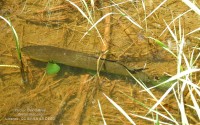Hong Kong grouper
(Epinephelus akaara)

Image source: Jo's Animal Database
Classification
General data
The Hong Kong grouper has a body which has a standard length which is around 2.7-3.2 times the depth of its body. The dorsal profile of the head is convex between the eyes. The preopercle is rounded and serrated with the serrations at its angle enlarged. The dorsal fin contains 11 spines and 15-17 soft rays while the anal fin has 3 spines and 8 soft rays. The caudal fin is rounded and the pelvic fin does not extend as far as the anus.
There are 61-64 scales in the lateral line.
The head and body have a pale brownish grey background colour, with the flanks and back covered with small red, orange or gold spots. There are 6 indistinct diagonal dark bars which can normally be seen on at least towards the back. The first bar is on the nape, the third bar runs through a dark brown or black blotch on the body at base of rearmost 3 spines of the dorsal fin while the final bar is on the caudal peduncle. These dark bars reach the base of dorsal fin. The margin of the dorsal fin is yellow or orange with a line of dusky yellow or orange spots along middle of spiny part of that dorsal fin and another along base of the fin. These rows have one spot on each membrane. The soft part of the dorsal fin as well as the caudal and anal fins have indistinct red or orange spots at their bases and dusky membranes faintly marked with small white spots.
The maximum published total length for this species is 58 centimetres (23 in), although they are more common at around 30 centimetres (12 in), and the maximum published weight is 2.5 kilograms (5.5 lb).
The Hong Kong grouper is found in the Western Pacific Ocean. It is found in southern Japan where it occurs in the Tsugaru Strait, the strait between Honshu and Hokkaido south along both coasts. It is also found off Korea, China and Taiwan as far as the Gulf of Tonkin. It may be found off Vietnam but this needs to be confirmed as the lone reported specimen may be a misidentification of Epinephelus fasciatomaculosus. There are unsubstantiated records from India and the Philippines.








